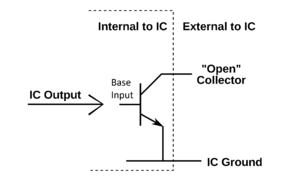- Open collector
-
An open collector is a common type of output found on many integrated circuits (IC). Instead of outputting a signal of a specific voltage or current, the output signal is applied to the base of an internal NPN transistor whose collector is externalized (open) on a pin of the IC. The emitter of the transistor is connected internally to the ground pin. If the output device is a MOSFET the output is called open drain and it functions in a similar way.
Contents
Function
In the picture above, the transistor base is labeled "IC Output". This is an internal output from the internal IC logic to the transistor. From the point of view of the transistor, this is the input which controls the transistor switching. The external output is the transistor collector, and the transistor acts as an interface between the internal IC logic and parts external to the IC.
The output essentially acts as either an open circuit (no connection to anything) or a connection to ground. The output usually has an external pull-up resistor, which raises the output voltage when the transistor is turned off. When any transistor connected to this resistor is turned on, the output is forced to nearly 0 volts. Open-collector outputs can be useful for analog weighting, summing, limiting, etc., but such applications are not discussed here.
A three-state logic device is unlike an open collector device, because it has transistors to source and sink current in both logic states, as well as a control to turn off both transistors and isolate the output.
Applications of open-collector devices
Because the pull up resistor is external and need not be connected to the chip supply voltage, a lower or higher voltage can be used instead. Open collector circuits are therefore sometimes used to interface different families of devices that have different operating logic voltage levels or to control external circuitry that requires a higher voltage (e.g., a 12 V relay).
Another advantage is allowing to connect more than one open-collector output to a single line. If all outputs attached to the line are in the high-impedance (i.e., logic 1) state, the pull-up resistor will hold the wire in a high voltage state. If 1 or more of the device outputs are in the ground (i.e., logic 0) state, they will sink current and pull the line voltage toward ground.
Open-collector devices are commonly used to connect multiple devices to a bus (i.e., one carrying interrupt or write-enable signals). This enables one device to drive the bus without interference from the other inactive devices - if open-collector devices are not used, then the outputs of the inactive devices would attempt to hold the bus voltage high, resulting in unpredictable output.
By tying the output of several open collectors together, the common line becomes a "wired AND" (positive-true logic) or "wired OR" (negative-true logic) gate. A "wired AND" behaves like the boolean AND of the two (or more) gates in that it will be logic 1 whenever (all) are in the high impedance state, and 0 otherwise. A "wired OR" behaves like the boolean OR for negative-true logic, where the output is LOW if any one of its inputs is low. Such circuit constructions are termed "wired-AND" and "wired-OR", respectively.
The open-collector transistor can be rated to withstand a higher voltage than the chip supply voltage. Such devices are commonly used to drive devices such as Nixie tubes, and vacuum fluorescent displays which require higher operating voltages than the usual 5-volt logic supply.
SCSI-1 devices use open collector for electrical signaling. [1] SCSI-2 and SCSI-3 may use EIA-485.
One problem with open-collector devices is power consumption, since they tend to require higher current minimums for correct operation. Even in the 'off' state, they often have a few nanoamps of leakage current (the exact amount varies with temperature).
 Active-low wired-OR / active-high wired-AND circuit using open-drain gates.
Active-low wired-OR / active-high wired-AND circuit using open-drain gates.MOSFET
The analogous connection used with MOS transistors is an open-drain connection. Open-drain outputs can be useful for analog weighting, summing, limiting, as well as digital logic. An open drain terminal is connected to ground in the low voltage (logic 0) state, but has high impedance in the logic 1 state. This prohibits current flow, but as a result, such a device requires an external pull-up resistor connected to the positive voltage rail (logic 1).
Note that microelectronic devices using open drain signals (such as microcontrollers) may provide a 'weak' internal pull-up resistor to connect the terminal in question to a positive voltage source/rail like Vdd of the device. Such weak pullups, often on the order of 100 kilohm, reduce power usage by keeping input signals from floating. External pullups are stronger (perhaps 3 kilohm ) to reduce signal rise times (as with I²C) or to minimize noise (as on system RESET inputs). Internal pullups can often be disabled for cases where there is an external one, or in other cases where they are not needed.
References
- ^ "Overview of SCSI Standards & Cables". http://www.scsita.org/terms/SCSI_Overview.html. 081214 scsita.org
- "Open Collector Outputs". http://www.acroname.com/robotics/info/concepts/opn_clct.html.
- "Chapter 4: Circuits". Honeywell Solid State Technical Documentation. http://content.honeywell.com/sensing/prodinfo/solidstate/technical/mr_chapter4.pdf.
- Horowitz, Paul; Winfield Hill (1989). The Art of Electronics (Second Edition ed.). Cambridge University Press.
External links
L
Categories:- Electronics stubs
- Digital circuits
Wikimedia Foundation. 2010.

